It’s surprisingly common to find upper elementary students who still need help with foundational spelling patterns, like short vowel sounds in closed syllable (CVC) words. But with older kids, not only is time of the essence—they need to catch up without missing out on grade-level work. Meanwhile, their self-esteem often suffers as they labor on work that other students mastered long ago.
So, what can you do to support students in the upper elementary grades who’ve not mastered some of the decoding skills typically mastered in the earliest grades?
Identifying Gaps and Tailoring Instruction
Start by pinpointing where your students need the most help, using a simple decoding or spelling inventory. Once you know the gaps, it’s time for some targeted small-group instruction. These sessions are crucial for filling those skills gaps and boosting reading confidence.
But even if students do still need to work with patterns like CVC (closed-syllable words) they don’t want to feel like they’re doing kindergarten work.
So, what can we do?
Multisyllabic Word Work Every Day: The Magic of BIG Words
Routinely incorporating multisyllabic words—or BIG words—is an often overlooked and underutilized solution to basic foundation skills work with older students who’ve fallen behind in their decoding skills.
It turns out that including at least some work with multisyllabic words in every phonics lesson can be an intervention game-changer for older students. Not only can it boost self-esteem, but it can actually accelerate progress.
CVC Patterns Aren’t Just in CVC Words
Closed syllables are not only the first syllable type most children are taught to read (bat, ten, sip, dog, run), but they are also the most frequently occurring syllable type in the English language. In fact, about half of the syllables in English are closed syllables. That means there are all kinds of multisyllabic words that can support and extend even the most basic phonics instruction with older students.
Practical Steps for Incorporating Big Words
Yes. Students still need practice with single-syllable words. But don’t shy away from opportunities to analyze, read, and write some carefully selected BIGGER (2-syllable words) and occasionally EVEN BIGGER (3–4 syllable words). You can include some BIGGER word practice in each small-group lesson.
Below is an example of a decoding practice word list that includes only closed syllables but builds from Warm-Up Syllables to BIGGER WORDS, to EVEN BIGGER words.
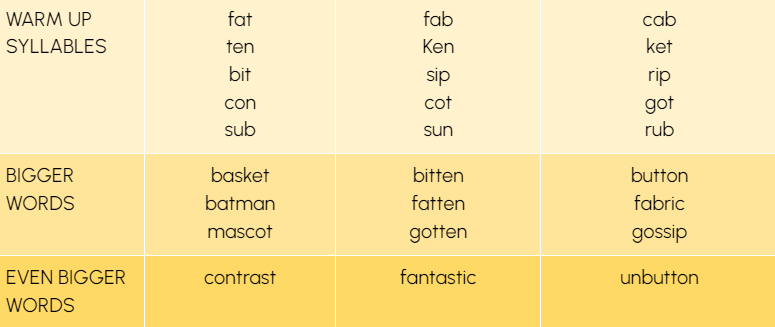
Warm-Up Syllables—There are some things you might notice about the warm-up syllables on this list.
- This example includes all five short vowel sound-spellings. Of course, depending on student needs and the focus of the lesson, it could also have been weighted more heavily toward a particular vowel sound-spelling.
- One of the warm-up words is a “nonsense syllable.” There are pros and cons to having students practice “nonsense words.” But when it comes to multisyllabic words, navigating nonsense syllables with ease becomes a critical skill because most of the syllables in multisyllabic words are “nonsense.” Take, for example, the word umbrella. To read this three-syllable word, it takes decoding three “nonsense” syllables. So, there are advantages to the occasional practice with these “nonsense” syllables that actually make up so many real words.
If you’d like a comprehensive collection of one-syllable words for use with your older students, our Short and Long Vowel Decodable Word Lists are available as a free download. We’ve created two comprehensive sets of one-syllable words (these are all real words) for the most common short and long vowel spelling patterns. You can get them here.
Bigger Words—As you look at the BIGGER WORDS selected for the second section in the table above, you may notice:
- The words are all two-syllable words with two simple closed syllables (CVC). In other words, the makeup of these words is CVC-CVC. This word type (along with simple compound words) offers an accessible entry point for multisyllabic word work.
- Many of the individual syllables in the BIGGER words were included as warm-up syllables in the first section. This provides supportive scaffolding from less to more difficult words. (i.e., fat and ten were both read as individual syllables in the warm-up, and fatten is included in the bigger words section).
- This section gives students two important kinds of practice wrapped up in a single word. First, this list provides practice with the targeted sound spellings—short vowels in closed syllables. Second, they provide an entry point for analyzing longer letter strings, looking for opportunities to chunk them into syllables.
- If you’d like a list of BIGGER WORDS (two-syllable) with closed syllables, we’ve made one for you! It’s the first in a collection of multisyllabic word lists we’re creating, and this one is organized in ways that will make it easy for you to select from a progression of less to more difficult words, as we did in the example table above.
Click image to get this resource.
EVEN BIGGER WORDS—If you want to extend your students’ practice a bit further, the EVEN BIGGER WORDS section (the third list of words in the table above) is a place for words with additional challenges. In the example, you may notice:
- The word contrast includes consonant blends (tr, st) in the second syllable. But it is still built with two closed syllables (con-trast).
- The word fantastic introduces a third syllable, but each syllable is spelled with a simple CVC pattern (fan-tas-tic ).
- The word unbutton also contains three closed syllables and is formed by attaching a prefix (which in this case also happens to be a closed syllable) to a word from a previous section (un-but-ton).
This last section lets you prime the work students are growing into and lets you watch students as they tackle a different level of challenge.
Don’t Forget Meaning-Making
While phonics is crucial, the ultimate goal of decoding in the first place is to comprehend the ideas the words represent. We don’t want to teach children the habit of word calling—mindlessly decoding without connecting to meaning—so it’s super important to incorporate meaning into your foundational skill lessons.
For instance, in a lesson containing the words in the table above, you might engage students in one or two short, meaning-focused interactions for each section. Here are some examples of ways to incorporate meaning:
- Warm-Up Syllables:
- Did you notice any warm-up syllables that don’t seem like actual words? If so, which ones?
- Find a word that means something you sleep on.
- Sub is another word for a sandwich on a long bun shaped like a submarine.
- BIGGER WORDS:
- See if you can use two or more words from the list in the same sentence.
- Share with your partner.
- EVEN BIGGER WORDS:
- I’m going to use the word contrast in a sentence.
- See if you can figure out what it means.
- “The cat’s black fur was a strong contrast to the white snow on the ground.”
If you’re interested in additional ways to bring more meaning into work with lists of words, we recently wrote this post about making word work meaning-FULL: Making Phonics and Word Study Meaning-FULL: 10 EASY Ways to Embed More Meaning Into Decoding Instruction.
Writing Multisyllabic Words
The most effective phonics and word work lessons don’t just focus on reading, they include opportunities for students to write as well. Decoding and encoding are reciprocal processes, so practice with one enhances skill with another.
If you’re interested in helping students write multisyllabic words with greater accuracy and automaticity, we have a tool to help. Follow the link below to download a step-by-step routine to help students write BIG words, aligning sounds and spellings across the whole word. We also elaborate on this brain-friendly approach to writing BIG words and offer examples in Shift 4 of Shifting the Balance and in the Online Class (3—5).
Click image to get this resource.
The Promise of BIGGER Words
-
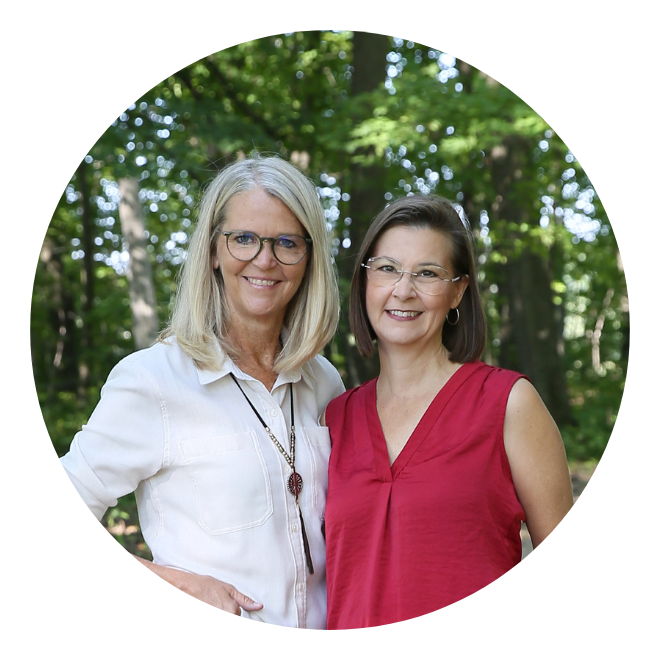
Jan Burkins and Kari Yates are authors, speakers, and consultants, who are dedicated to helping teachers around the world translate reading science into simple instructional moves that help teachers make learning to read easier for their students while still centering meaning-making, engagement, and joy.
Recent Posts

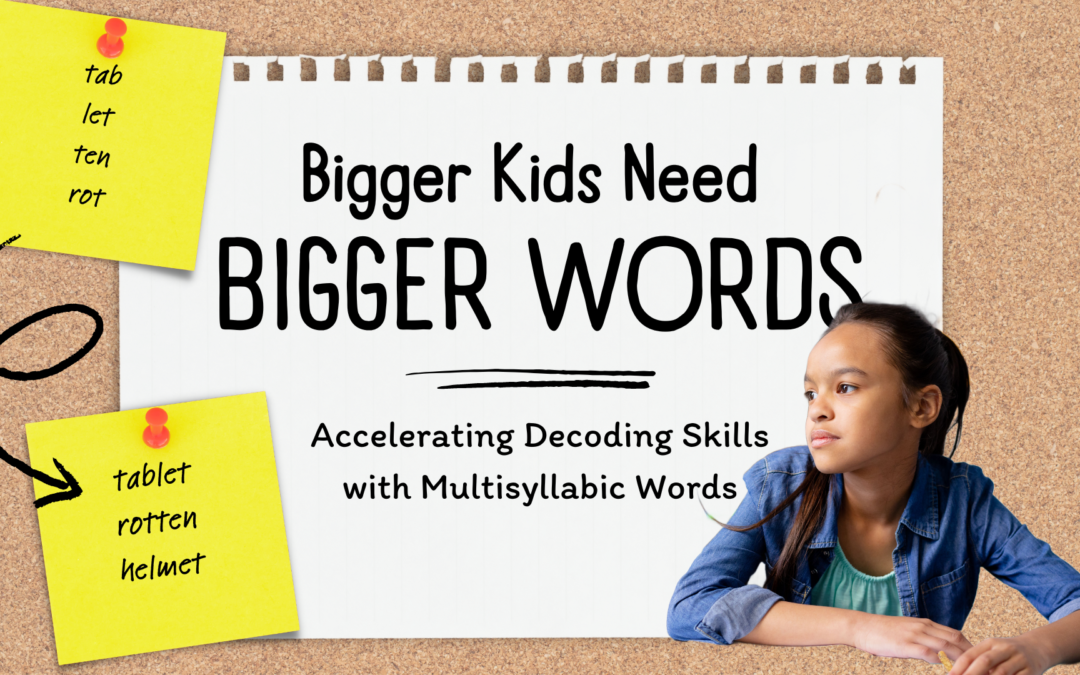
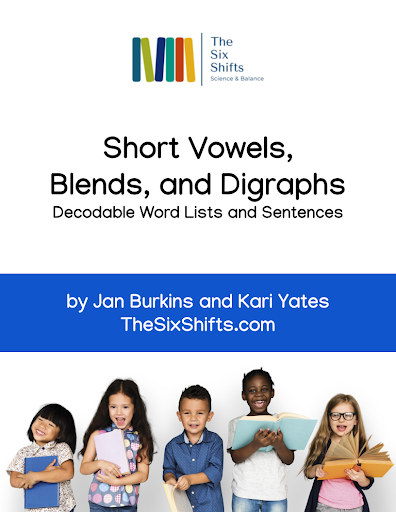
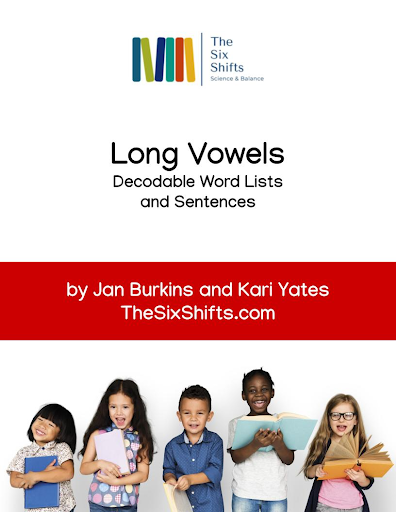
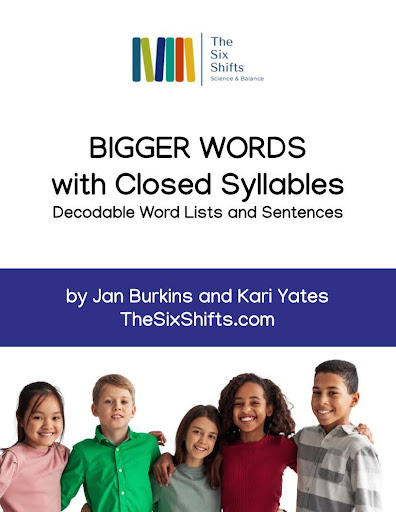
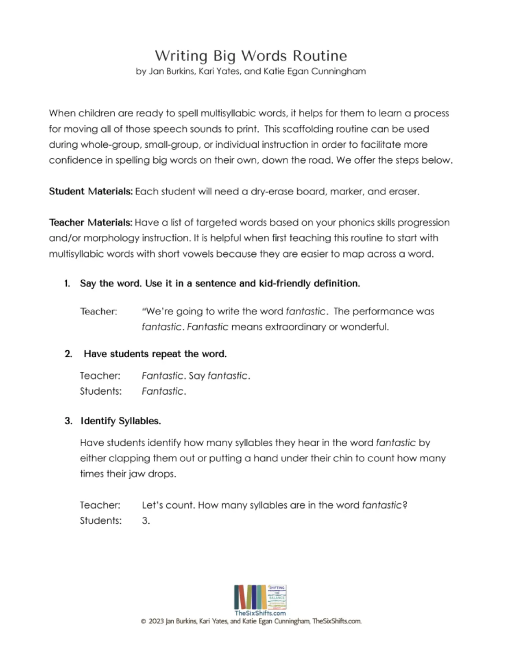

Greatly appreciated this post and the free resource! I love the way you explain everything and am sharing it with as many people as possible. Thank you
I love your work! This is how I learned and I still use today – it’s automatic now but when I reflect on how I pronounced the work it is decoding every time!!
Hi Kari and Jan,
Thank you for this very helpful article. Do you happen to know of any decodable passages of books that will match up to these word lists with the big words? I have a 5th grade student who is working on these exact skills, closed syllables and blends, etc, but the passages I have are for 1st and 2nd grade students.
Thank you,
Staci
Hi Staci! 😊 Thanks so much for your kind words. We completely understand the need for decodable passages that align with more advanced phonics skills for older students. You might find our BIGGER WORDS: Decodable Word Lists & Sentences resource really helpful! It includes structured, scaffolded practice with two-syllable closed syllable words (like helmet, dentist, and sandwich), making it a great fit for your 5th grader working on blends and closed syllables. You can check it out here: https://thesixshifts.com/downloads/bigger-words-two-syllable-decodable-word-lists/
Let us know if you need more recommendations—happy to help! 📚✨